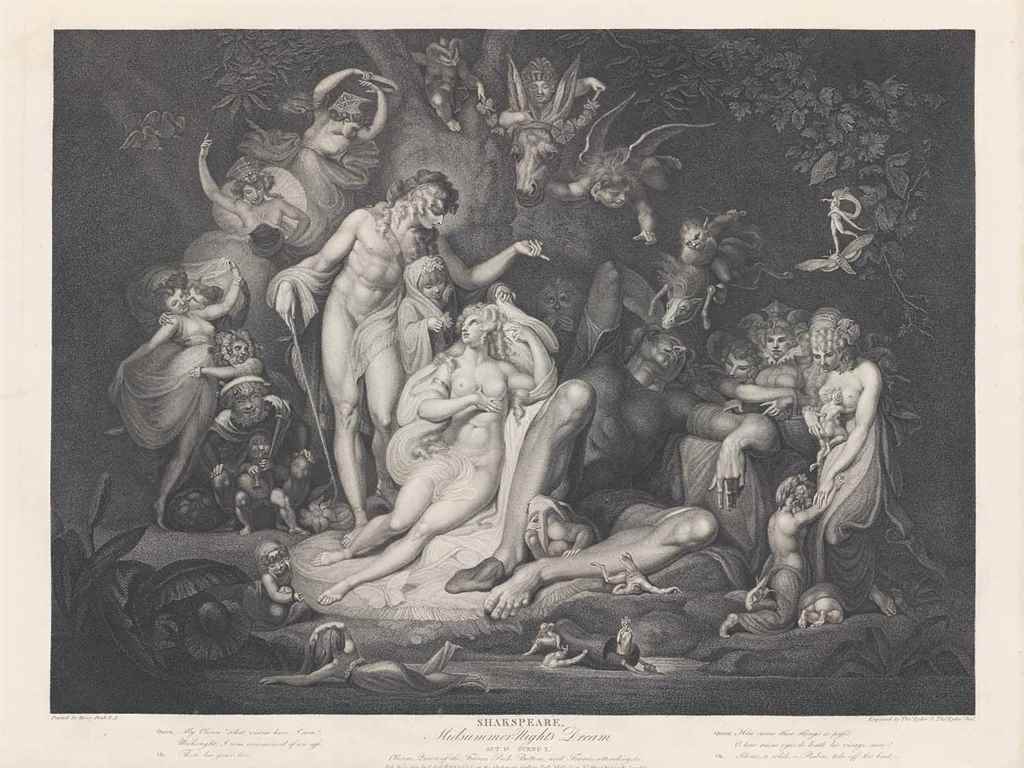SHAKESPEARE, William (1564-1616) -- A George III, mulberry-wood writing-box stamped on the base 'SHAKESPEAR'S , WOOD , SHARP , STRATFORD ON AVON' [but probably by George Cooper], the hinged rectangular top carved with mulberries around Shakespeare's arms, on a punched ground, enclosing a divided interior containing two glass wells (lacking stoppers), the reverse of lid with print of Shakespeare, the sides carved with a trellis pattern around flower-head filled roundels, the underside previously [but not necessarily originally] with bun feet (underside split causing minor loss, hinges replaced). A BOX CARVED FROM LOGS OF THE MULBERRY TREE TAKEN FROM SHAKESPEARE'S GARDEN AT NEW PLACE, and reputedly planted by the poet himself. New Place in Stratford-on-Avon was built in the late 15th century by Sir Hugh Clopton, erstwhile Lord Mayor of London, and was the second-largest building in Stratford when Shakespeare bought it on 4 May 1597. Ownership eventually returned to the Clopton family when it was given to Sir Hugh Clopton as a wedding gift. Although the original house was demolished in 1702, the gardens remained, containing the mulberry tree that the younger Sir Hugh always maintained had been planted by Shakespeare in 1609 (when mulberry trees were first introduced to the area). Following Sir Hugh Clopton's death in 1751, the house was sold to the Rev. Francis Gastrell in 1753. Gastrell demolished the house in 1759, having first cut down the mulberry tree and sold the logs, some of which were purchased by the silversmith and clockmaker Thomas Sharp (1799). At this period of 'bardolatry', led by figures such as Samuel Johnson and David Garrick objects fabricated from this wood were much prized. They included tea caddies and small boxes or caskets. Following Garrick's Shakespeare Jubilee of 1769, the freedom of the town had been awarded to the actor in a box of the wood, and the writer George Keate (who had made the presentation to Garrick) was in turn given an inkstand made from the tree. Examples of pieces bearing the stamp of either George Cooper or (as here) Thomas Sharp are known. As Sharp took over Cooper's business but continued to employ him, it is likely that the carving was Cooper's work. The potential for fraud did not go unrecognised. In his play The Jubilee , Garrick presents a tinker selling 'Toothpick cases, needle cases, punch ladles, tobacco stoppers, inkstands, nutmeg graters and all sorts of boxes made out of the famous Mulberry Tree', who is challenged by a second trader with the accusation that 'His goods are made of old chairs and stools and colored to cheat gentlefolks with' ( Plays , Carbondale and Edwardsville, Illinois: 1980-1982, I, iii, 69-71 and 75-6). Nonetheless, Garrick possessed various pieces manufactured from the wood (and even purchased blocks of the timber for himself), thus helping to give these artefacts a genuine and lasting association with the revival of national interest in Shakespeare.
SHAKESPEARE, William (1564-1616) -- A George III, mulberry-wood writing-box stamped on the base 'SHAKESPEAR'S , WOOD , SHARP , STRATFORD ON AVON' [but probably by George Cooper], the hinged rectangular top carved with mulberries around Shakespeare's arms, on a punched ground, enclosing a divided interior containing two glass wells (lacking stoppers), the reverse of lid with print of Shakespeare, the sides carved with a trellis pattern around flower-head filled roundels, the underside previously [but not necessarily originally] with bun feet (underside split causing minor loss, hinges replaced). A BOX CARVED FROM LOGS OF THE MULBERRY TREE TAKEN FROM SHAKESPEARE'S GARDEN AT NEW PLACE, and reputedly planted by the poet himself. New Place in Stratford-on-Avon was built in the late 15th century by Sir Hugh Clopton, erstwhile Lord Mayor of London, and was the second-largest building in Stratford when Shakespeare bought it on 4 May 1597. Ownership eventually returned to the Clopton family when it was given to Sir Hugh Clopton as a wedding gift. Although the original house was demolished in 1702, the gardens remained, containing the mulberry tree that the younger Sir Hugh always maintained had been planted by Shakespeare in 1609 (when mulberry trees were first introduced to the area). Following Sir Hugh Clopton's death in 1751, the house was sold to the Rev. Francis Gastrell in 1753. Gastrell demolished the house in 1759, having first cut down the mulberry tree and sold the logs, some of which were purchased by the silversmith and clockmaker Thomas Sharp (1799). At this period of 'bardolatry', led by figures such as Samuel Johnson and David Garrick objects fabricated from this wood were much prized. They included tea caddies and small boxes or caskets. Following Garrick's Shakespeare Jubilee of 1769, the freedom of the town had been awarded to the actor in a box of the wood, and the writer George Keate (who had made the presentation to Garrick) was in turn given an inkstand made from the tree. Examples of pieces bearing the stamp of either George Cooper or (as here) Thomas Sharp are known. As Sharp took over Cooper's business but continued to employ him, it is likely that the carving was Cooper's work. The potential for fraud did not go unrecognised. In his play The Jubilee , Garrick presents a tinker selling 'Toothpick cases, needle cases, punch ladles, tobacco stoppers, inkstands, nutmeg graters and all sorts of boxes made out of the famous Mulberry Tree', who is challenged by a second trader with the accusation that 'His goods are made of old chairs and stools and colored to cheat gentlefolks with' ( Plays , Carbondale and Edwardsville, Illinois: 1980-1982, I, iii, 69-71 and 75-6). Nonetheless, Garrick possessed various pieces manufactured from the wood (and even purchased blocks of the timber for himself), thus helping to give these artefacts a genuine and lasting association with the revival of national interest in Shakespeare.


.jpg)

.jpg)
.jpg)

.jpg)

.jpg?w=400)
/571/1210571.jpg)

.jpg?w=400)


Testen Sie LotSearch und seine Premium-Features 7 Tage - ohne Kosten!
Lassen Sie sich automatisch über neue Objekte in kommenden Auktionen benachrichtigen.
Suchauftrag anlegen